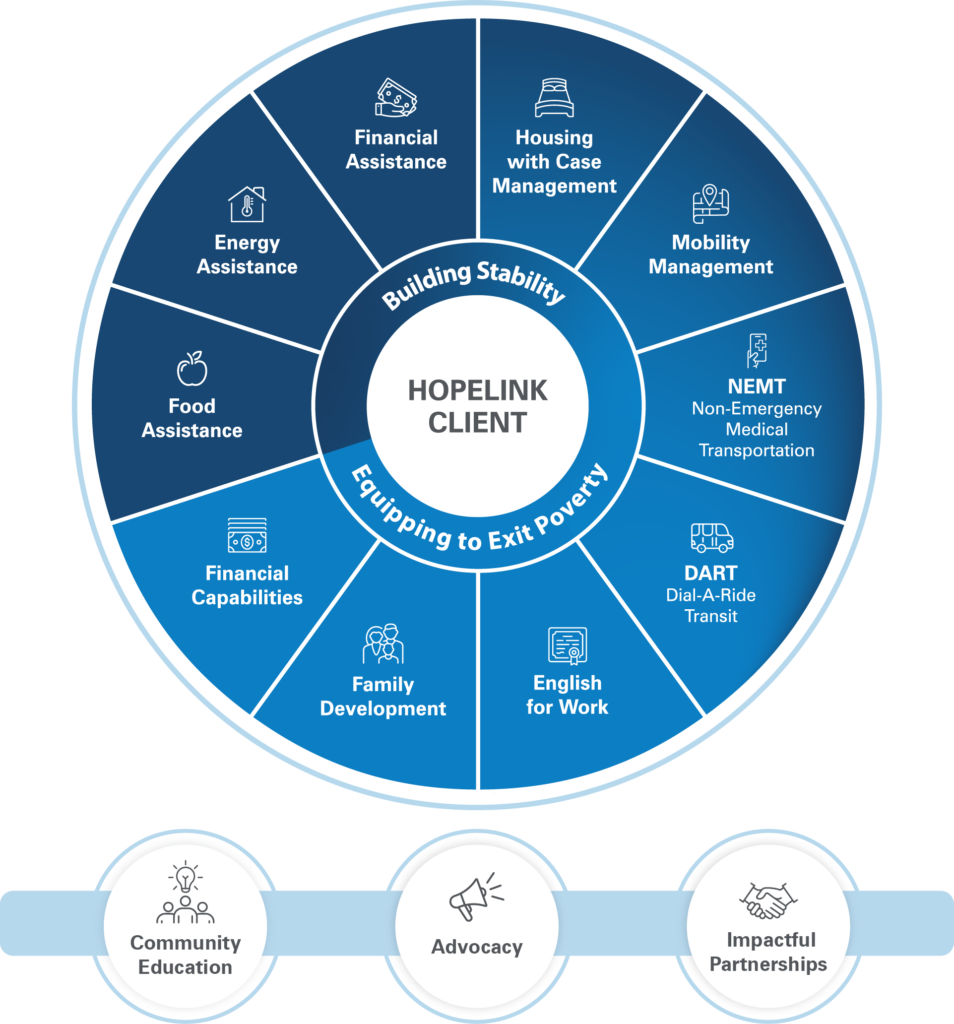Redefining Our Path: Updating Our Mission, Values, and Theory of Change
At Hopelink, our work has always been rooted in the belief that every person deserves the opportunity to thrive. But in the face of a rapidly changing world, we knew it was time to take a closer look at how we talk about our work — and how our guiding frameworks reflect the holistic services we provide today.
Over the past 15 months, we engaged in an inclusive and intentional process to update our mission, values, and Theory of Change. We embarked on this effort with an overarching commitment: to ensure that the heart of our organization, our values, and our purpose are defined by the people who live and breathe our mission daily.
Our last mission and values update was over 20 years ago, and our original Theory of Change, authored in 2013, had become outdated. We’ve grown in scale, scope, and strategy; it was time for our words and models to grow as well.
Step 1: Reimagining Our Mission and Values
Centering community voice
We began by surveying over 380 team members and facilitating focus groups to ask, “What does Hopelink mean to you?” “What values feel true to the way we work?” From those conversations, a clear theme emerged: our teams wanted our mission to reflect not just what we do – but why and how we do it, with dignity, accessibility, and accountability.
Updating the mission
Our new mission: “Hopelink equips people to exit poverty through comprehensive services, impactful partnerships, and advocacy for equitable opportunities for all” reflects who we are today — an agency deeply committed to meeting immediate needs while addressing the systems that perpetuate poverty. It acknowledges the agency and power of the individuals and families we serve and centers our work in equity, accessibility, and collective impact.
To ensure the updated mission was both inclusive and accessible, we formed a small working cohort to refine the language, making sure it could be easily understood and translated into our community’s top languages: English, Spanish, Vietnamese, Korean, Portuguese, Chinese, Russian, and Ukrainian. We wanted everyone—regardless of language or background—to feel a sense of belonging and understand what Hopelink stands for.
Our previous mission, “To promote self-sufficiency for all members of our community; to help people make a lasting change,” was last revised in 2000 when we changed our name from the Multi-Service Center of North and East King County to Hopelink — a name that better reflected our growing scope. But since then, our programs have expanded, our understanding of systemic poverty has deepened, and our commitment to equity has sharpened, prompting this important evolution.
Redesigning our values
Our values — originally drafted in 2005 — also needed refreshing. Our team members wanted aspirational, actionable values rooted in their lived experiences while also aligning with our anti-poverty mission. Together, we redesigned our values to reflect our belief in inclusion, growth, community-centeredness, and data-informed stewardship.
Step 2: Transforming Our Theory of Change
From linear to circular: centering the client journey
As we reimagined our mission and values, we also looked at Hopelink’s Theory of Change: the roadmap that explains how our work creates real impact. The original version followed a linear path based on the Self-Sufficiency Matrix, which didn’t reflect how people move through our programs. It unintentionally suggested that there was a “right” way to receive support when, in truth, everyone’s journey is different.
So, we did what felt right: we brought together a diverse group of staff and leaders from across the agency to reimagine the Theory of Change while maintaining the foundational pieces that are integral to our community. The result? An updated, circular Theory of Change that puts the client at the center, highlighting flexibility, dignity, and self-determination every step of the way.

This updated model recognizes that people can come to Hopelink at any point in their journey—whether looking for housing, food, education, transportation, or financial help to build stability and become equipped to exit poverty. And, how when a service falls outside our offering, we connect folks with trusted partners who can step in and support.
In line with our process on the updated mission and values, we prioritized equity-centered design—focusing on accessibility through thoughtful choices in fonts, spacing, language, and layout. We also ensured that the visuals and colors clearly convey our work and are easy to engage with, while accurately reflecting the full scope of Hopelink’s impact.
What’s different now and why it matters
Hopelink’s updated mission, values, and Theory of Change align every part of our organization — from frontline service to executive strategy — with a shared vision for impact.
- For staff, they provide a common language and clarity about our purpose, including their stake in it.
- For clients, they express how Hopelink can support them with clarity and empathy.
- For partners, volunteers, and donors, they tell a cohesive story about how Hopelink creates change at both an individual and community-wide level.
Together, these updates affirm who we are today and ground us in a future guided by equity, accessibility, and the lived experiences of our community. By centering our clients and challenging the systems that sustain poverty, we’re building a path forward that meets immediate needs while driving long-term, systemic change.
